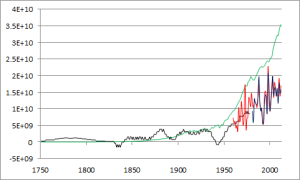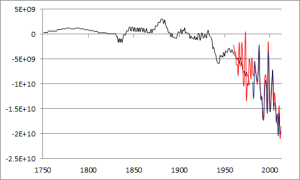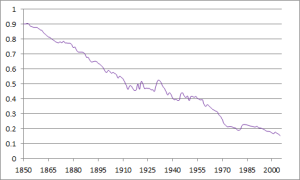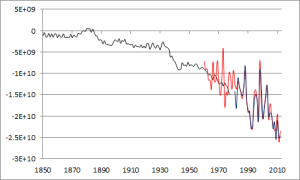In a recent conversation, I expressed some skepticism about the accuracy of the conversion of CO2 emissions scenarios, into estimates of concentrations. This is important because it adds an additional layer of inaccuracy of future estimates of global warming due to future increases in CO2: It is currently my opinion that the emissions scenarios themselves are not to be taken seriously as accurate but even if they were, the carbon cycle models appear to overestimate how much an increase in emissions leads to an increase in concentrations. This will tend to lead to overestimating future climate forcing and therefore, future warming.
In investigating the issue further, I came across another uh, curiosity. From here, one can download estimates of global fossil fuel burning CO2 emissions back to 1751. From here you can download historic CO2 concentrations (Mauna Loa back to 1959, global averages back to 1980), and from here, you can get ice core estimates of concentrations. According to this, our handy dandy conversion factor for ppm to metric tons of CO2 should be 7769028871.39107 tons/ppm. So from there, we can estimate the net mass flux into the atmosphere each year. It is from doing something like this that people estimate the so called “airborne fraction.” We’ve discussed that before, (see also discussion at Jeff’s blog). At any rate, compare emissions from fossil fuel burning to actual mass flux in and out of the atmosphere, and we get a graph like this:
 Green is metric tons of emissions from fossil fuel burning, black is the ice core based mass flux, red the Mauna Loa based mass flux, and blue the global avergae concentration based mass flux. We can also take the differences:
Green is metric tons of emissions from fossil fuel burning, black is the ice core based mass flux, red the Mauna Loa based mass flux, and blue the global avergae concentration based mass flux. We can also take the differences:
 Which shows that non fossil fuel burning sources and sinks of CO2 represent a large and growing net sink of CO2. But that’s not really what I deemed especially curious. What I deemed curious is, that before about 1910, these other sources and sinks represented, usually, a net source of CO2. Hm. That’s kinda interesting to me.
Which shows that non fossil fuel burning sources and sinks of CO2 represent a large and growing net sink of CO2. But that’s not really what I deemed especially curious. What I deemed curious is, that before about 1910, these other sources and sinks represented, usually, a net source of CO2. Hm. That’s kinda interesting to me.
Now, as I understand it, there is also a contribution to total anthropogenic emissions from land use, which could mean that one interpretation of the above result should be that before about 1910, land use emissions contributed more to rising CO2 than fossil fuel burning. Hm. Does that make sense to anyone else? Well, there are estimates of emissions from land use from 1850-2005. Converting from teragrams to metric tons of carbon and from carbon to CO2, I can get comparable measures of land use emissions, and fossil fuel emissions. This is the ratio of Land Use emissions to total emissions:
 Roughly, this aligns with what I just said-around the beginning of the twentieth century, fossil fuel burning started to represent about half of all emissions, and represented an increasing fraction of emissions thereafter. I can also (estimating emissions from land use after 2005 by extrapolating the rate at which the ratio between land use and fossil burning emissions declined from 1996-2005) find the net natural CO2 mass flux: the difference between the change in the amount of atmosphere, and the anthropogenic emissions (land use + fossil burning):
Roughly, this aligns with what I just said-around the beginning of the twentieth century, fossil fuel burning started to represent about half of all emissions, and represented an increasing fraction of emissions thereafter. I can also (estimating emissions from land use after 2005 by extrapolating the rate at which the ratio between land use and fossil burning emissions declined from 1996-2005) find the net natural CO2 mass flux: the difference between the change in the amount of atmosphere, and the anthropogenic emissions (land use + fossil burning):
 Okay so finally we get to the really curious thing. What was the natural net source of CO2 in the early 1880’s? I don’t think it’s Krakatoa: in the first place, it appears in other cases volcanic eruptions strengthened the natural sinks, besides which the net natural inflow starts before then. Or perhaps it is simply that human emissions were underestimated around that period? It’s hard for me to say.
Okay so finally we get to the really curious thing. What was the natural net source of CO2 in the early 1880’s? I don’t think it’s Krakatoa: in the first place, it appears in other cases volcanic eruptions strengthened the natural sinks, besides which the net natural inflow starts before then. Or perhaps it is simply that human emissions were underestimated around that period? It’s hard for me to say.
Either way, however, we can see something very important from the above: An increasingly large amount of CO2 is never making it into the atmosphere, but is instead being absorbed by nature. An increasingly strong net natural sink would imply some interesting things: first, that future increases in CO2 that is in the atmosphere (and thus exerting a warming influence) will probably be significantly smaller than future emissions. Second, that nature is adaptive, and tends to stabilize itself in spite of our activities. Third, if emissions underwent a sudden decrease by a large fraction, the atmospheric concentration could, if sinks have a significant inertia in their size, actually decrease almost immediately. This last point is quite contrary to the idea that the CO2 concentration would remain elevated for thousands of years even if human emissions went to zero immediately. Such claims appear, to me, to be quite erroneous. Which I take as all the more reason to doubt the carbon cycle models used to estimate future CO2 concentrations can be trusted as accurate.
But please note: while I am skeptical of carbon cycle modeling, that skepticism does not extend to the attribution of increasing CO2 to human emissions: for me, it’s a simple matter of algebra: The amount of CO2 we have emitted is more than enough to account for the increase in atmospheric CO2. As such, it is illogical to suggest natural CO2 could account for the increase, since the natural CO2 mass flow to the atmosphere has had to be large and negative. That is, nature has taken CO2 out of the atmosphere, not put it in.
Leave a comment